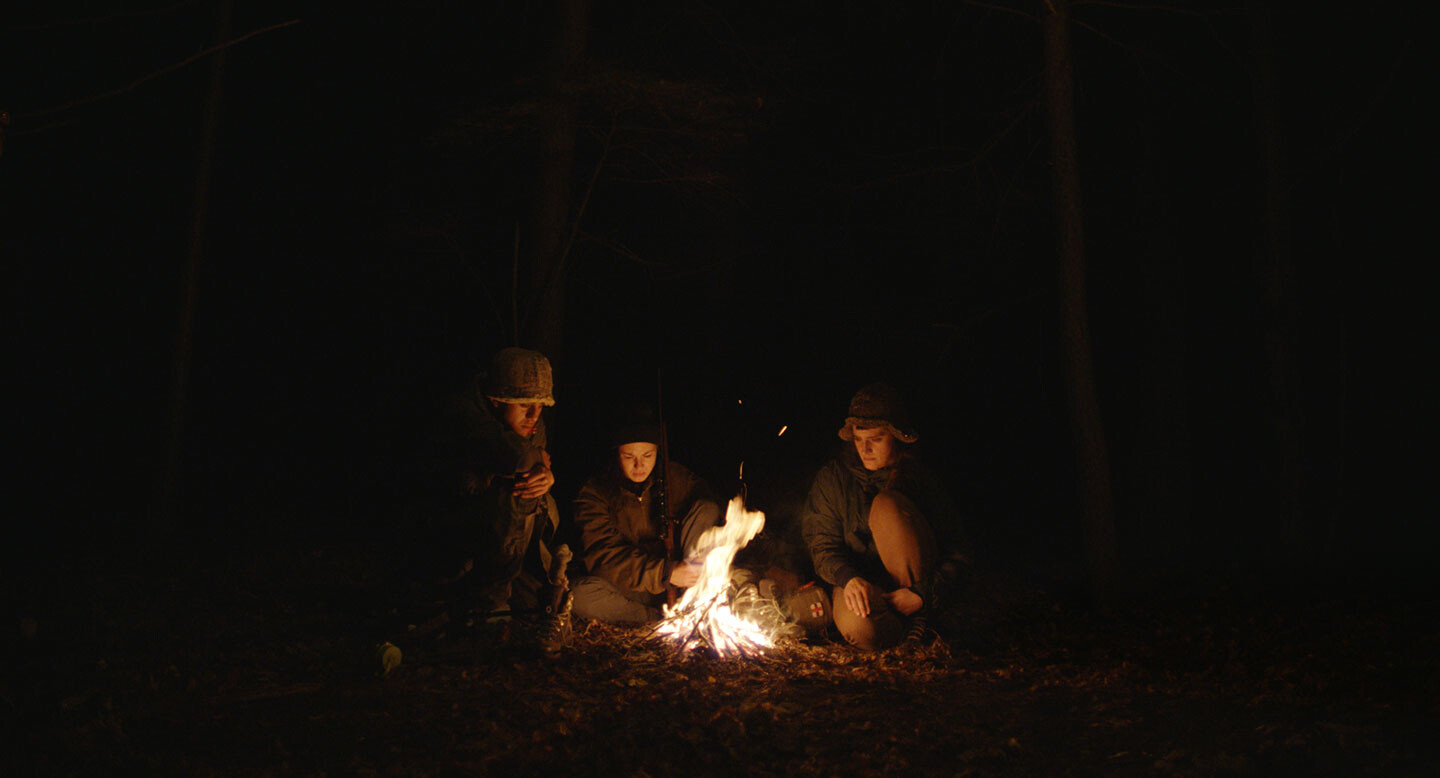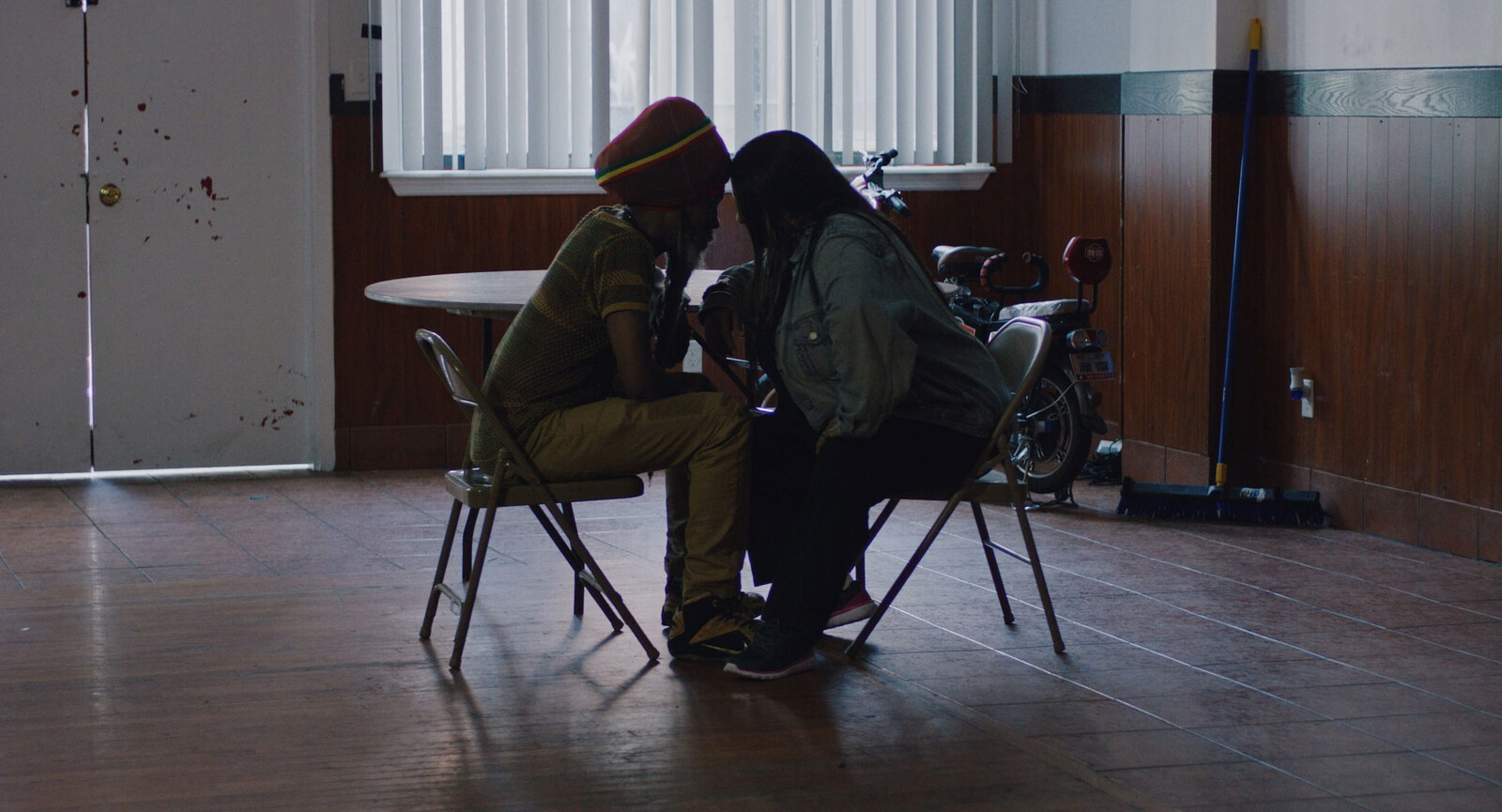How could I practice poetry when I hear the provisional government say that indigenous people are undeserving of a bridge to the future? What can I say? I’ll tell them: We don’t need that bridge; we don’t want that bridge. We want to walk the way of the water. We want to walk the way of the rivers.
—Sónia Guajajara, speech at the meeting “A Voz dos que Cultivam a Terra: Diálogos de Luta e Arte Cosmopolítica” (The Voice of Those Who Cultivate the Earth: Dialogues on Struggle and Cosmopolitical Art), Teatro Oficina, São Paulo, 20161
For the last few years, I’ve been working through two sentences that have come up again and again in the process of my writing, be it theory or fiction. The first goes like this:
There is only one planet, but there are many worlds inside of it.
The second:
It is only white people who have the privilege of living in one world; everyone else must live in many worlds, theirs and ours (I mean, mine) in order to survive.
With the first, I’m paraphrasing anthropologist Marisol de la Cadena, who writes the history of modernity and colonialism as the reduction of many worlds to only one world.2 The latter adds to it my own self-reflection as a white European person who has worked with and about indigenous worlds.3
To start with Cadena: this world reduction is a busy and complex affair, rooted in violence. It involves not only the management of othered bodies, but also the management of nature, that is, of ecosystems, including animals and plants, and the management of cosmologies, where spirits, stars, clouds, and minerals play their part. To destroy and distill a plurality of worlds into a single, streamlined capitalist modernity has meant to narrow and simplify the gap between nature and culture everywhere, and in doing so, to push other livelihoods into invisibility. I am thinking particularly of Native American histories, which, despite their great diversity, can generally be said to ascribe agency to both immaterial and material actors.4 More broadly, however, one should look for such erasure anywhere the richness of diverse socio-cosmologies has been forced into the shape of what anthropologist Philippe Descola has called “naturalism”: Western modernity’s characteristic disagreement—its hygienic division—between nature and culture. In Cadena’s words, anywhere “heterogeneous worlds that do not make themselves through the division between humans and nonhumans—nor do they necessarily conceive the different entities in their assemblages through such a division—are both obliged into that distinction and exceed it.”5
To ask about the future of these many foreshortened worlds is to inquire into this excess. It demands that we ask where these futures have gone, how they survive, and where they are going. It also demands that we ask how this reduction of worlds connects to the issue of futurity itself.
Currently, the future doesn’t look very promising. Philosopher Franco “Bifo” Berardi goes so far as to claim that the future is done for—that it is over. For him, “the century that trusted in the future,” by way of science-driven progress and the belief that tomorrow would be better than today, has pushed itself into a dead end, with technology leaving capitalism’s social contradictions unresolved and its degradation of the biosphere unaddressed.6
Climatologists keep warning us that soon there will not be much planet left to inhabit; according to the latest United Nations IPCC report, we have a decade to decarbonize the economy and keep global temperature rise below 1.5ºC. The technocratic politics of “green” transition through incremental ecological goals has utterly failed; not even those same climatologists believe in gradual steps anymore, instead calling for systemic change.7 In 1984, the UN published an environmental report titled, ironically enough, “Our Common Future.” I was born that same year—I’ve been waiting for change, goal after unmet goal, my entire life.
Unsurprisingly, images of dystopia are thriving everywhere; from postapocalyptic novels to film, art in the early twenty-first century is bleak. Don’t believe any of it.
I don’t mean to deny that coastal cities will suffer rising waters, that melting glaciers across the Himalayas will flood nearby valleys, or that Spanish farms will struggle with heatwaves and dust coming in from an ever-drier North Africa. Nor am I saying that ideas of futurity (even utopias!) aren’t alive and kicking in the minds of tech billionaires, from Silicon Valley to Shenzhen. Their imagined futures do not contradict Berardi’s claim. On the contrary: tech futurism is nothing but a perpetuation of a globalized modern belief in machinic and information-driven progress, which, in the end, is what led us into our current catastrophic cul-de-sac.
However, it is important to remember that some futures never went anywhere—they were not allowed to—and yet they survive. These are futures that have been suppressed and canceled by colonial power, and that only now, between the cracks of this single dominant modernity, are finding their way towards visibility. I’m talking about parallel futures. By this I mean futures that have always been present, but that, together with the worlds they belong to, have been forced into one future only. Parallel futures push us to think the future sideways, rather than ahead, fomenting those future worlds that are already here, but which continue to be sidelined and made invisible. And that is something altogether different than sitting around waiting for the future to arrive.
That these resistant futures are strengthening themselves in times of (our—I’m speaking to white people like me here) crisis, and that some of us (again, we) now wish to learn from those who have lived and continue to live through the apocalypse (thinking especially of indigenous people), is telling of the miserable self-righteousness of our modernity.
Two recent films have helped me think through this conflict between a single linear future and what I’m calling parallel futures, existing simultaneous with one another. It is perhaps unsurprising that both films are authored, fully or partially, by indigenous filmmakers, and position their narratives and characters within various versions of dystopia or apocalypse—which are just placeholders for the long centuries of mass dehumanization wrought by modernity, capital, and colonialism. Because the two films deal so explicitly with apocalyptic imaginaries, they are also helpful in highlighting contradictions inherent in anarchic thought (particularly anarcho-primitivism) on one hand, and post-human and post-natural positions on the other.
In 2016, Adam and Zack Khalil released their first feature film, Inaate/se (It shines a certain way to. To a certain place. It flies. Falls). Adam and Zack are two Native American, Ojibwe filmmakers living in New York City. At its core, their experimental documentary film tells the story of the Anishinaabe Seven Fires Prophecy. In their own words:
The accounts of our life that have been handed down to us by our elders tell us that many years ago seven prophets came to the Anishinaabe. These prophets left the people the seven predictions of what the future would bring. Each of these prophecies is called a fire, and each fire referred to a particular era of time that would come in the future. Thus the teachings of the seven prophets are now called the Seven Fires Prophecy of the Ojibwe.8
Through the lens of the Khalil brothers, this becomes the story of a cycle of seven indigenous generations surviving, and hopefully surpassing, settler colonialism in Turtle Island (North America), from first contact until today. While Zack Khalil’s voice narrates the seven stages of the prophecy, softly yet defiantly—as only the voice of insiders can—the camera shines upon the landscape of the Great Lakes region. In particular, the filmmakers focus on the city of Sault Ste. Marie in Michigan, which sits at the confluence of Lake Superior and Lake Huron, at the border between the present-day settler nations of the US and Canada. Sault Ste. Marie, which was first called Bawating, meaning “gathering place,” is an historic site for the Ojibwe, as the film’s narration tells us early on. From this situated piece of land, the Khalils look back in time, to both respect and retrieve the Seven Fires Prophecy.9 Their camera becomes a time-traveling machine—cosmopolitical no less.
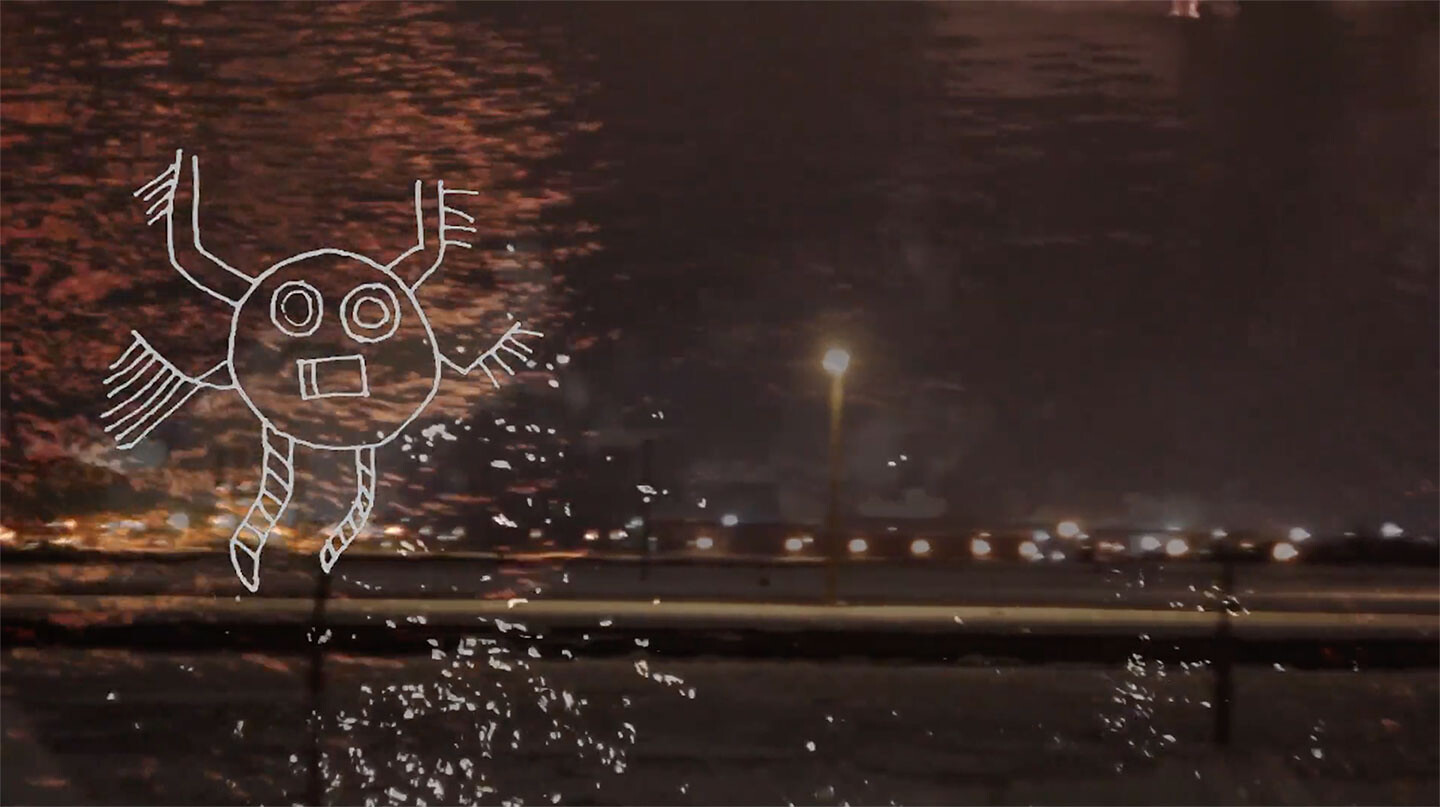

Adam and Zack Khalil, Inaate/se (It shines a certain way to. To a certain place. It flies. Falls), 2016.
In the film’s first minutes, Adam and Zack sit with a tour guide and curator from a local museum. They find a photograph of their great-great-great-grandfather, on a boat surrounded by rapids, dating to the 1800s. They tell the curator about the photograph but, in a typical move of erasure, the old man barely registers their remarks. Nevertheless, the Khalils take this moment to decisively insert themselves into the narrative of the film—though as Ojibwe, they would be part of the story regardless. From there, they run through the “seven-generations cycle,” complicating causes and consequences between past and present, as well as a portrayal of the seventh generation as endpoint. In an interview given around the time of the film’s release, they detail the implications of the seven-generations cycle: “From an Ojibway perspective, we’re taught to consider our actions within a continuum of seven generations into the past and seven into the future, that all of our present-day actions are related to these former and yet-to-come relatives.” Thus, they distort the rigidity of periodic time, as embodied by historical and ethnographic archives, while claiming a space of opacity, secrecy, and communal adventure against the settler world.10 Again, in voice-over, Zack Khalil explains the concept of the seventh prophet:
The seventh prophet that came to the people is said to have been different to the other prophets. He had a strange light in his eyes. He said: in the seventh fire a new people would emerge; they will retrace their own steps to see what was left by the trail. Their steps will lead them to the elders, who will tell them what to do on their journey. But many of the elders will have fallen asleep. They will awaken to this new time with nothing to offer. Some of the elders will be silent out of fear; some of the elders will be silent because no one will ask anything of them; the task of the new people will not be easy. The new people will remain strong in their quest. There will be a rebirth of the Anishinaabe nation.
In response to a first draft of this essay, Adam Khalil further explained to me that the arrival of the seventh generation does not literally mean the end of the prophecy. It both is and is not the final generation. If present, past, and future are bound up with one another, each generation is in all generations. The future is an ongoing struggle.
Fueled by Inaate/se, I want to ask how we can think through colonization and decolonization as a matter of futures. Colonization—of bodies and minds but also of nature itself—has always been as much about the negation and control of possible futures as about the erasure of the past.11 This erasure of the past, of course, is a process of the colonial present. The colonizer makes every effort to absolutely break and bury the traditions of those it subdues. Colonial power implies managing every possibility that other people’s pasts could ever return. Such control also aims to preempt the unfolding of a diversity of other contesting futures. Think about every other possible future that could have been, but wasn’t—how these were, and are to this day, reduced to only one future: capitalist modernity.
Colonial power and capitalism don’t always go hand in hand. Nonetheless, the history of Western colonialism is the history of the rise of capitalism—even if colonialism exceeds capitalism itself. What this history tells us is clear: colonialism always subjugates other possible futures to a more “productive” one. This capitalist future orients the present, narrowing a diversity of anthropological worlds—that is, of different socio-ontological relations between natures and cultures—to its own single world. Under capital, the present is always produced from the standpoint of future capital accumulation, and the modern, progressive promise of future wealth—including health and life expectancy—is always the loss of someone else’s. One community’s clean water is another’s polluted stream.12
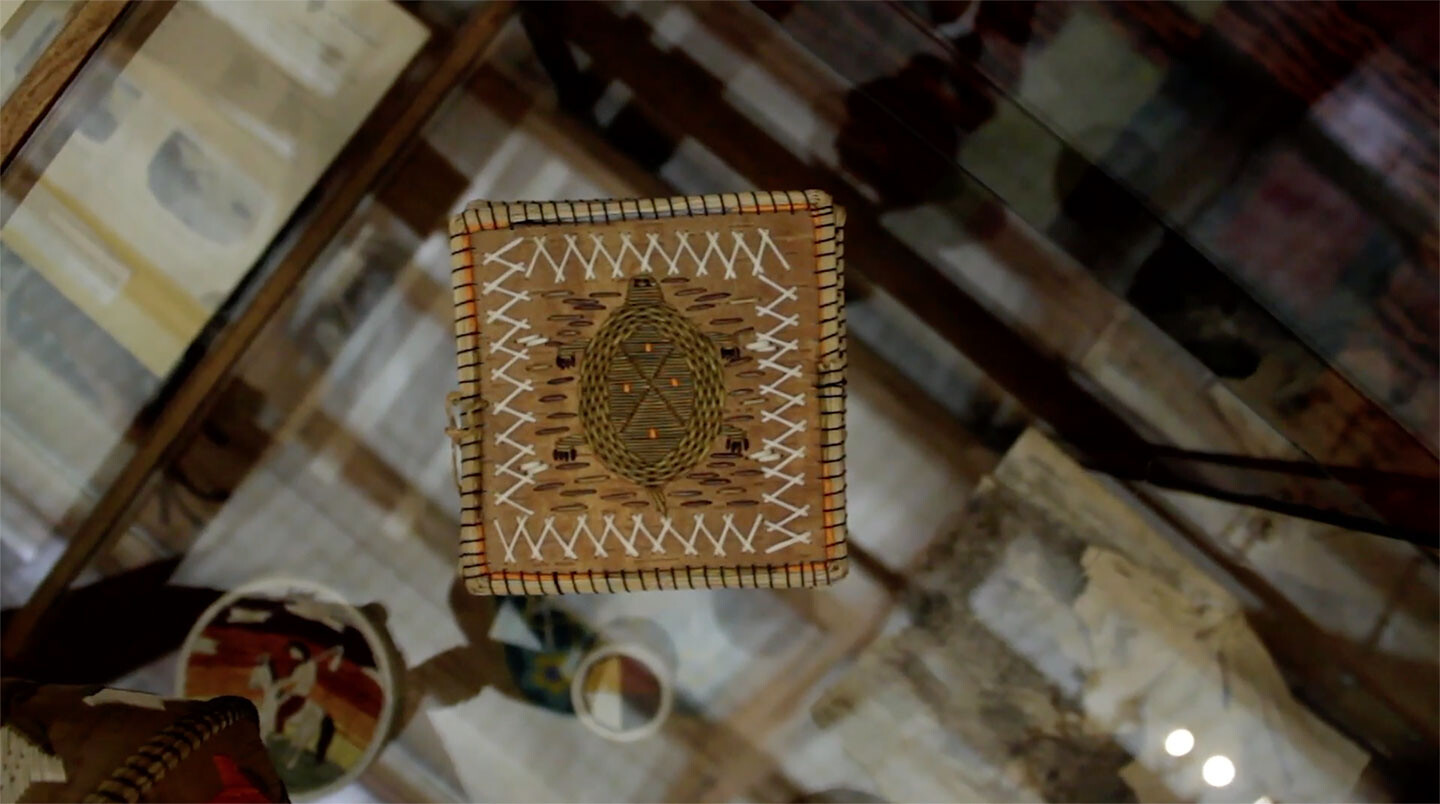

Adam and Zack Khalil, Inaate/se (It shines a certain way to. To a certain place. It flies. Falls), 2016.
Writing from an Afrofuturist standpoint, artist and writer Kodwo Eshun suggests that the colonial present is managed by both a preemptive and a predictive power. “Preemptive” means that colonial power must control the past so as to deny the emergence of any future other than the one desired by the colonialist. “Predictive,” in contrast, implies that power must manage the present in such a way that the future is predetermined in advance. It is the active production of future horizons, compliant with power, that comes to shape the present. Eshun makes this explicit when he talks about Africa from a developmental perspective:
African social reality is overdetermined by intimidating global scenarios, doomsday economic projections, weather predictions, medical reports on AIDS, and life-expectancy forecasts, all of which predict decades of immiserization.
These powerful descriptions of the future demoralize us; they command us to bury our heads in our hands, to groan with sadness … Within an economy that runs on SF [science fiction] capital and market futurism, Africa is always the zone of the absolute dystopia. There is always a reliable trade in market projections for Africa’s socioeconomic crises. Market dystopias aim to warn against predatory futures, but always do so in a discourse that aspires to unchallengeable certainty.13
Borrowing a term from anthropologist Michael Fortun, one could call this preemptive prediction a “future anterior”: the forceful imagination of a technoscientific future that by its very utterance determines the shape of things to come. The future anterior orients the present toward a predetermined goal, while also rereading the past in its image.14 This is perhaps why Eshun writes that it is not the future that emerges from the present, as one would normally think, but rather the present (and the past) that arrives from the future. Colonial power creates a future in advance, so that no other will take its place.
For Eshun, then, Afrofuturism’s goal is to be “concerned with the possibilities for intervention within the dimension of the predictive, the projected, the proleptic, the envisioned, the virtual, the anticipatory and the future conditional.”15 This means interrupting the channeling of the future into a single pathway, while also debunking prejudiced expectations about the viability of other futures that lie outside the norm.
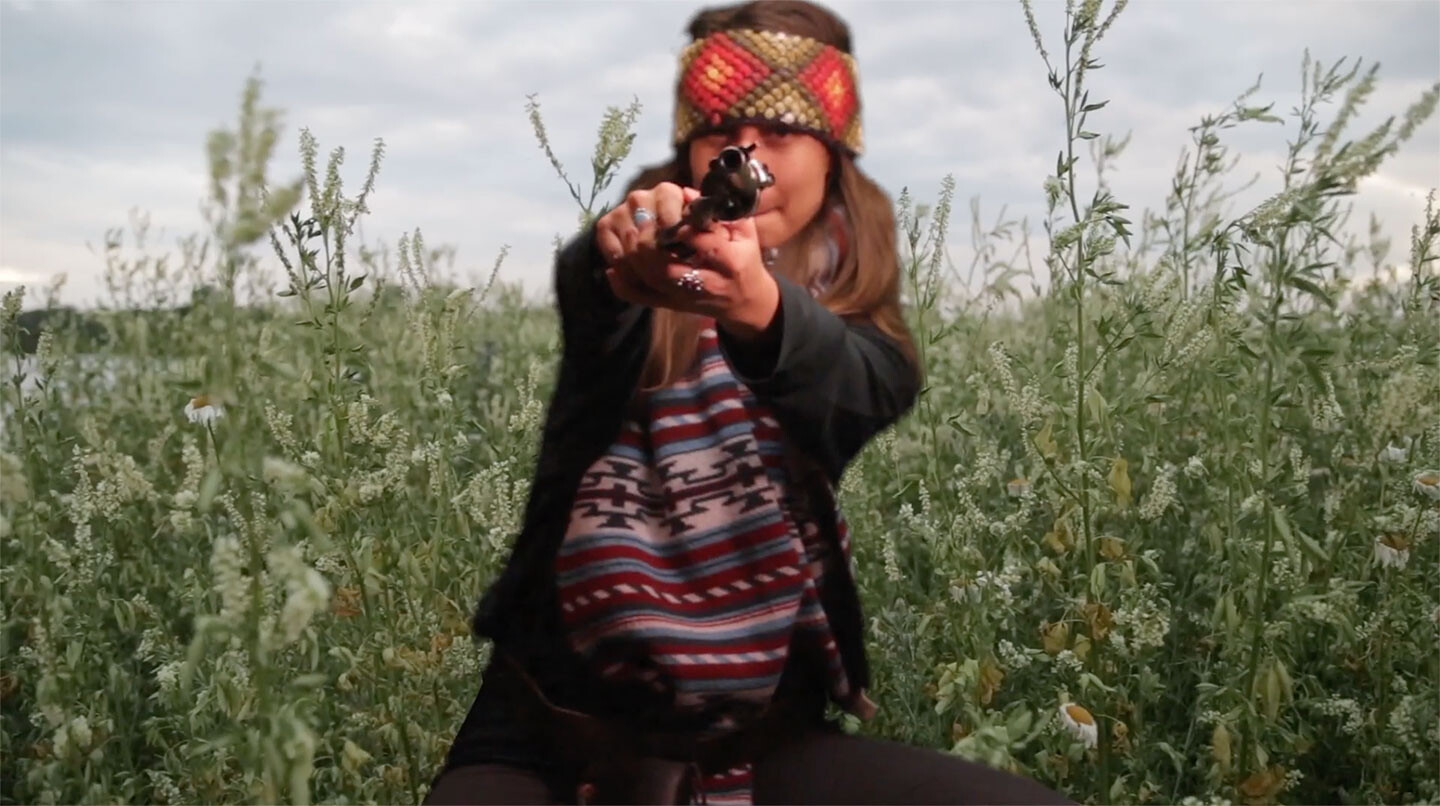

Adam and Zack Khalil, Inaate/se (It shines a certain way to. To a certain place. It flies. Falls), 2016.
In its own way, is this not what Inaate/se speaks to? Not only the erasure of tradition and the trauma that this deletion imprints upon every subsequent generation, but also the return of the past in the form of other contesting futures, which have survived in spite of everything? Instead of a past broken into shards that the suppressed of modern history are bound to never-endingly reclaim and retrieve, Inaate/se opens the way for the past to return, but from the future. The future anterior, the Khalils show us, can be appropriated and rerouted. Decolonizing struggles are as much about retrieving lost pasts as about reclaiming possible futures.
Survivance, to cite Anishinaabe novelist Gerald Vizenor, yes—but also sovereignty.16
For the Khalils, this implies not only contesting the rigidity of preordained colonial images, but also warping their own Native tradition, exploding it with all that surrounds it, with the innovations that come from within and outside one’s world. In an interview, they clarify their position by criticizing the notion of preservation itself: “The anthropologist’s encapsulating gaze ignores the fact that, for indigenous communities, tradition is not an immutable set of truths handed down by revelation, but a set of ever-evolving social practices whose continuity cannot be repaired by preservation—only elaborated through struggle, and finally achieved under conditions of genuine self-determination.”17
Inaate/se may not be the most obvious example of the science-fictional aesthetics of “Indigenous Futurism,” a term coined by Anashinaabe scholar Grace L. Dillon to describe Native artists who work with science fiction to both refuse the representational expectations of “the Great Aboriginal Story” and play with boundary crossings, claiming the spaces of science, technology, and futurity as their own. Nonetheless, the film employs certain key strategies Dillon finds in such authors, from what she terms “Contact” and “Native Apocalypse” to “Biskaabiiyiang,” an Anishinaabe word “connoting the process of ‘returning to ourselves.’”18 In so doing, Inaate/se promises an ethics founded on an inhabited futurity, which, no matter how many blows it has suffered, still manages to survive. The Khalils do not attempt to surpass the trauma of erasure; they inhabit and politicize it for a new world to come. In this way, they make the dystopia lived through seven generations a starting point for livelihood.
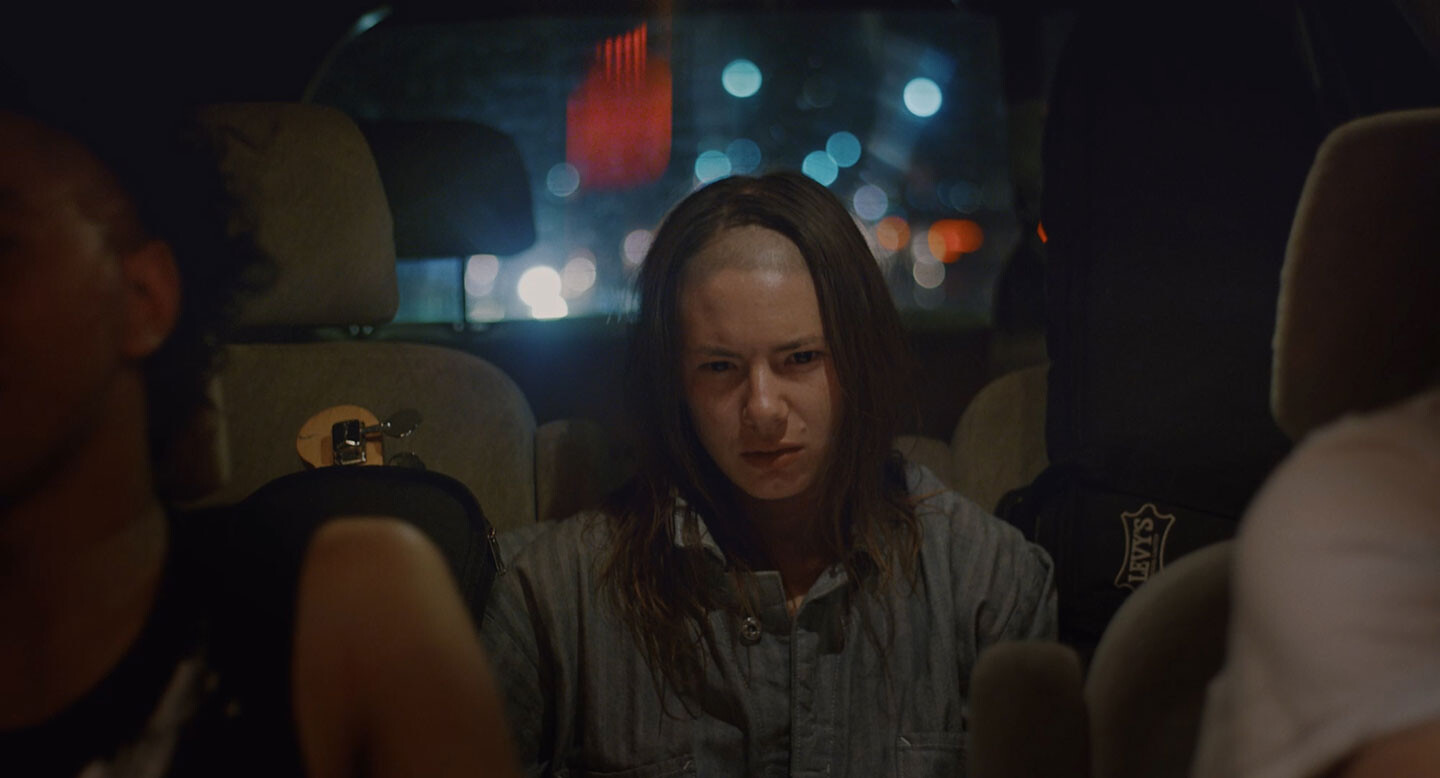

Adam Khalil and Bayley Sweitzer, Empty Metal, 2018.
I’ll put it differently this time: the sovereignty of survivors.
With this in mind, I want to look at 2018’s Empty Metal—Adam Khalil’s new feature film made in collaboration with Bayley Sweitzer. The film further advances the above strategies of Contact, Indigenous Apocalypse, and “returning to ourselves,” connecting them with other genealogies and parallel futures.
Far more action-packed than Inaate/se, with its introspective documentary feel, Empty Metal tells the fictional story of a punk-ish band from Bushwick, Brooklyn, who become involved in a payback plan against police brutality. After a failed gig, they are approached by a telepathic young woman, a member of a secret sect of conspirators with very different backgrounds (one Native American, one Rastafari, and one white European mystic). She convinces them to fly across the country and kill two cops and a vigilante who, famously, faced no criminal charges for their respective murders of black people. After they carry out the killings, the three band members have no other option but to go on the run and lead a fugitive life in a corrupt and surveilled nation—aerial drone are a constant, haunting presence throughout the film.
The plot is based on the premise that “the end” does not come to all at the same time, that the end of the world is unevenly distributed and racially defined. Akin to what one finds in the writings of Brazilian anthropologist Eduardo Viveiros de Castro, or in novelists like the above-mentioned Gerald Vizenor and the African American writer Andrea Hairston, the film asserts that one must learn from those who have lived through an apocalypse lasting five hundred years and survived.19 In a voice-over, the young telepath, of Mohawk descent, says:
The word “apocalypse” literally means an uncovering or disclosure of knowledge, usually something hidden; a vision of heavenly secrets that can make sense of earthly realities. The end of the world, on the other hand, is a matter of perspective. Most people think that the end of the world will come to everyone at the same time. For us the end of the world happened a long time ago. My mom says it’s a good thing to come out of nowhere, to be ignored; and then just show up.
This would seem to point to an indigenous vision of apocalypse—that is, not as destruction but as survivance and continual rebirth. But despite the immediate pleasure of the revenge killings, at the end of the film it is unclear what the sect’s semi-libertarian, semi-anarchist plan might offer to future generations, besides a life of tentative survival eked out across the US wastelands. While Inaate/se is a story that looks beyond the end-time, offering the promise of a non-compromising indigenous futurity, Empty Metal appears to dwell in dystopia. This is perhaps the film’s biggest weakness, but it also presents an opportunity to claim the urgent necessity of an anthropology of dystopias. To each world a dystopia—and which world’s dystopia is Empty Metal talking about?
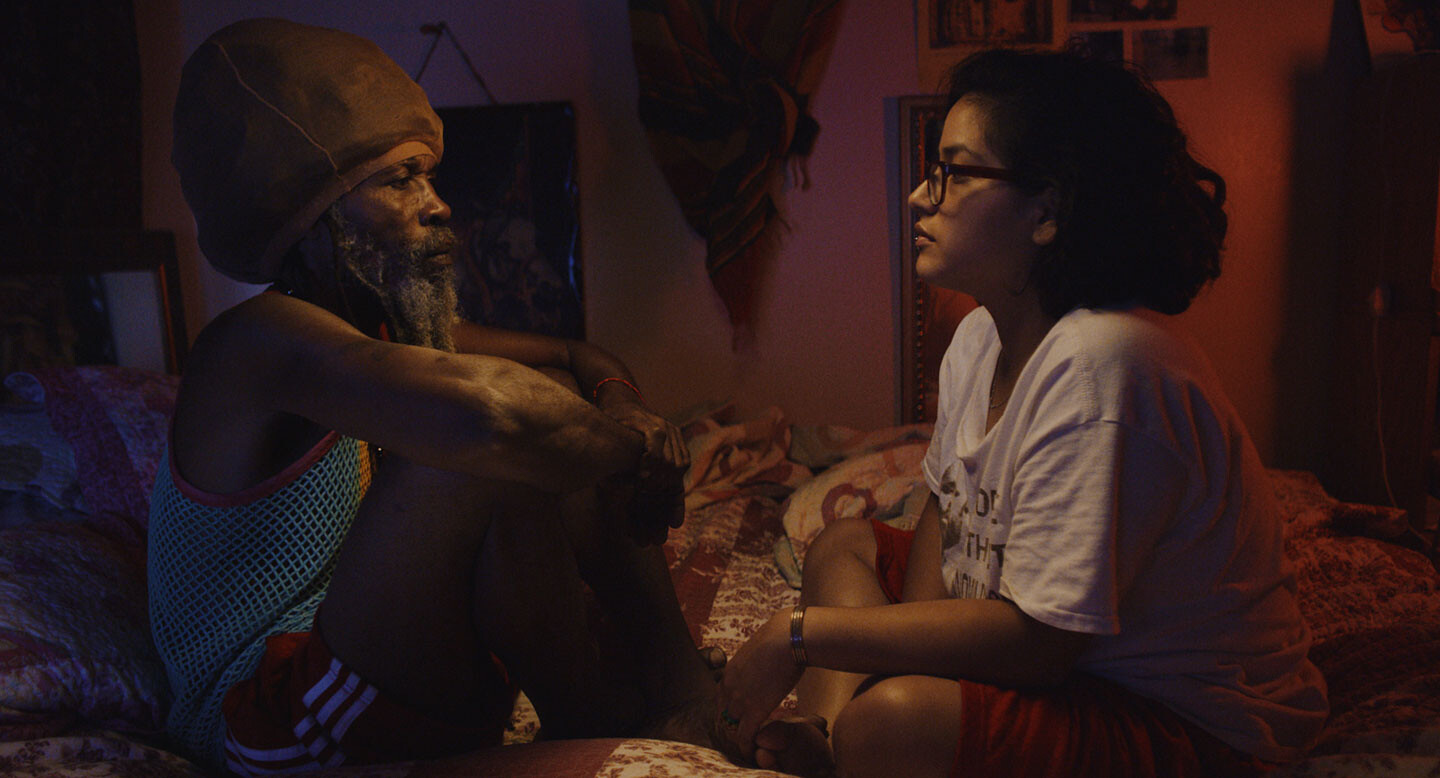

Adam Khalil and Bayley Sweitzer, Empty Metal, 2018.
Clearly, the dystopia we find at the end of the film will not do. But nor will utopia. Indulging in catharsis and revenge, Empty Metal offers little in the way of a future. Or put another way, it seems to perpetuate a particular future, one in which, because everything is in ruins, the only way forward is a sort of anarchic return to nature, on the run from the police–military complex. Sure, the secret sect gets its way; in this sense they are successful. The problem, however, is that this anarcho-primitivism has a particular genealogy too, belonging to a particular world: a white people’s world. In this world, where there once was plenty (at the cost of countless others), now there is little (due to the dire consequences of the white settler-colonial project—that is, of their one world taking too much space).
The sad irony here is that while indigenous peoples have actually lived this image of “wasteland apocalypse” for centuries, white people, when faced with their own self-induced meltdown, turn this imaginary into their own image of decay. We see this everywhere in contemporary fiction, from the Mad Max movies to Cormac McCarthy’s novel The Road, all the while forgetting how Native Americans have long lived amidst ecological breakdown, from bacteriological infections to deforestation. In other words, white people have appropriated the ruins of others, as if through this “assimilation” they might erase colonial differences between themselves and all those they have oppressed. This final appropriation is what comes after the end of “the century that trusted in the future.”


Adam Khalil and Bayley Sweitzer, Empty Metal, 2018.
In a reverse way then, one could say that whiteness is the subject of Empty Metal. This much is suggested by its mock portrayal of a white-supremacist military cell plotting against the US government. Unlike the multicultural secret sect, the members of this cell ignore the dangers of drone surveillance and end up getting killed—while rubbing themselves on the corpse of a wild boar to absorb its dead scent. By contrast, the film’s portrayal of the Bushwick-based punk trio is more ambiguous, swaying between a corrosive picture of the band’s posturing and apolitical coolness, and an obvious affection for their sudden shift from apathy to political engagement. By forcing the band into a life in the wastelands, the telepathic sect and the filmmakers alike place them in the shoes of those whom progress has left behind. Perhaps this is part of the sect’s plan: pushing whiteness, its comforts and signifiers (even if embodied, as in the band members, by people of color), into a position akin to indigenous and black survival.20 A double reparation: the band must kill in the name of those continuously othered; and then they too must experience exteriority, that is, life outside the dream of progress and beyond the capitalist promise of both wealth and health.
Taken together, the films allow for a reflection on two strands of anarchist thought that anchor this post-futuristic dystopia. One strand looks at indigenous lives, which remain forever unavailable to white people, or available only by mediation or projection. The other belongs to the European anarchist genealogy of communes and riots. The first has provided the source material for many a “return-to-nature” story, beginning with Engels’s imagined primordial matriarchy in his 1884 The Origin of the Family, Private Property and the State, famously based on Lewis Morgan’s flawed evolutionist anthropology. This strand runs all the way up to the anthropologies of Pierre Clastres, with his concept of “society against the state,” based on field work among the Yanomami and the Guayaki indigenous peoples of South America, and Marshall Sahlins, with his portrayal of hunter-gatherer societies as communities of affluence rather than scarcity.21 The second strand is perhaps best exemplified by European political and intellectual movements and ideas stemming out of Tiqqun and The Invisible Committee—a countercultural form of insurrection and social organization, of both the people and the forces of production, beyond the means of representative democracy, which has of late gone headless, as in the multitude of the gilet jaunes.
The problem with both genealogies is that they cannot resist teleology. Similar to post-humanist and post-naturalist philosophies in the West, these anarchist genealogies, despite their good intentions, remain bound to a politics of surpassing through progress—the return to nature; the taking of the Bastille. Post-humanism strives to go beyond the confines of the human, understood as socially constructed against or in contrast to the “others” of modernity, and also biologically produced by extracting wealth/health from the colonies. This worldview obliterates other understandings of what “human” can mean—understandings rooted in worlds where more-than-human entanglements are placed above the atomization of bodies. Both anarchist genealogies suffer from this same syndrome insofar as they strive to surpass past trauma, rather than surpassing within trauma. In this way, they remain very much modern, for the therapy remains the same: move forward.


Adam Khalil and Bayley Sweitzer, Empty Metal, 2018.
But the Indigenous Futurism exemplified by both Inaate/se and Empty Metal is simultaneously more outrageous and humble than such positions. The films tell stories of inhabited and appropriated dystopias, because they know that if they built their visions of the future strictly on the surpassing of trauma, they would fall back into the trap of modern teleology—messianic time. Parallel futures, then, might mean this: an other politics capable of inhabiting trauma and erasure so as to claim better futures from within it. Parallel futures are made visible by care and invention, fostering connections between differences within and beyond power. A bullet shot, past patriarchal cops and vigilantes, to the future after all, for this is where Empty Metal goes beyond Inaate/se, bringing all these future connections center stage, into the struggle: Native, black, queer, even white, and all the inventive, unnamable spaces and performances in between. As the last fugitive band member in Empty Metal says, her face lit by fire, just before the film fades out: “A forging of impossible alliances, a scrambling of stereotypes.” Sure, unlike Inaate/se, Empty Metal may crave one resolution, one world—hence the trap of apocalypse. No matter. Within Empty Metal too lie plenty of futures, plotting with each other behind the backs of a repressive world that has lasted far too long.
Original speech in Portuguese: “Como eu vou fazer poesia quando eu escuto um governo interino dizer que os povos indígenas não merecem uma ponte para o futuro? O que é que vamos dizer? Vou dizer isso para ele: Nós não precisamos dessa ponte; nós não queremos essa ponte. Nós queremos passar por dentro da água. Nós queremos passar por dentro dos rios.” Translated by the author.
See A World of Many Worlds, eds. Marisol de la Cadena and Mario Blaser (Duke University Press, 2018).
I am indebted to, among others, artist and activist Zahy Guajajara, who has acted in my films; indigenous leaders Ailton Krenak and Sonia Guajajara, to whom I have strived to listen closely; and anthropologists Tânia Stolze Lima and Eduardo Viveiros de Castro in Brazil. In a US context, the films of Adam and Zack Khalil, to whom I dedicate this essay, and the writings of Gerald Vizenor, Sherman Alexie, and Kim Tallbear have taught me many lessons.
Of course, one can also look to Europe for such erasure, pointing to the transition from medieval to early modern thought in Europe and the history of witch hunting, land grabs, and enclosures. For two seminal references on early modern Europe, see Carolyn Merchant, The Death of Nature: Women, Ecology, and the Scientific Revolution (Harper One, 1980); and Silvia Federici, Caliban and the Witch: Women, the Body, and Primitive Accumulation (Autonomedia, 2004).
Marisol de la Cadena, “Uncommoning Nature,” in “Supercommunity,” special issue, e-flux journal no. 65 (2015) →. Italics are mine.
Franco “Bifo” Berardi, After the Future (AK Press, 2011). To be clear, Berardi’s “century” refers to the period of the twentieth century from the rise of the Russian and Italian futurist vanguards to the emergence of neoliberalism in the late 1970s. This would make it, in historian Eric Hobsbawm’s words, a “short twentieth century.” A wider view of this “trust in the future” would have to begin, at least, with the “long nineteenth century” and its devotion to naturalist science, objectivity, and engineering.
This was made clear to me in conversations I had with environmental and climate specialists while in residency at the Potsdam Institute for Climate Impact Research (PIK), the top-rated climate center in the world. For a glimpse of such frustration over climate gradualism, see the discussion between Hans Joachim Schellnhuber, former director of PIK, and Bruno Latour at Haus der Kulturen der Welt, 2018 →.
This is a transcript from the film’s narration. According to the Khalils, this part of the film script was adapted from the version of the Seven Fires Prophecy found in The Mishomis Book, originally published in 1988, by Ojibwe writer Edward Benton-Banai.
My use of the word “situated” is inspired by Donna Haraway’s poignant term “situated knowledges.” I want to imply that the particular story told by the Khalil brothers could only be told from this particular place, or at least imbued with the spirit of this particular place (which is also where the brothers grew up).
Conversation between Suzy Halajian and Adam and Zack Khalil, Vdrome, 2019 →. Italics are mine. In the interview the brothers say that they use jokes and playfulness as strategies for subverting both their own traditions and settler mentalities. They cite the essay “Indian Humor” by Native American author and activist Vine Deloria, Jr. as an important influence in this regard. See Vine Deloria, Jr., “Indian Humor,” in Custer Died for your Sins: An Indian Manifesto (Macmillan, 1969), 146–67.
The erasure of the past is, of course, canonical to the making of modernity, even if modernity, too, is a fiction. The radical novelty of modernity, with its universal figure of humanity and its elevation of science as the standard of truth, went hand and in hand with the fetishization of othered cultures and natures. This is why the “orientalism” of the Romantics, the “primitivism” of the surrealist art-vanguards, the “spiritualism” of Russian abstraction, and the “Buddhism” of the counterculture could nonetheless be included in modernity’s narrative of progress. As Bruno Latour stated long ago, modernity has never been pure: it is full of “factishes,” sublimations, and transferences. In other words: for each culture a different nature. See Bruno Latour, We Have Never Been Modern (Harvard University Press, 1993).
I explore this topic in greater detail in my article “If Futurity Is the Philosophy of Science Fiction, Alterity Is its Anthropology: On Colonial Power and Science Fiction.” Here I examine the plantation as a science-fictional space, with coloniality, capital, and the control of futurity at its center. See Futurity Report, eds. Sven Lütticken and Eric de Bruyn (Sternberg Press, forthcoming 2019).
Kodwo Eshun, “Further Considerations on Afrofuturism,” CR: The New Centennial Review 3, no. 2 (2003): 292.
Michael A. Fortun, “The Human Genome Project: Past, Present, and Future Anterior,” in Science, History, and Social Activism: A Tribute to Everett Mendelsohn, eds. Garland E. Allen and Roy M. MacLeod (Kluwer Academic Publishers, 2001), 332–69.
Eshun, “Further Considerations on Afrofuturism,” 293.
Gerald Vizenor, Manifest Manners: Narratives in Postindian Survivance (University of Nebraska Press, 1999).
Adam and Zack Khalil, “The Violence Inherent: Native Videographers Shoot Back,” The Offing no. 20, September 2016 →.
Grace L. Dillon, Introduction to Walking the Clouds: An Anthology of Indigenous Science Fiction (University of Arizona Press, 2012), 1–12.
See Déborah Danowski and Eduardo Viveiros de Castro, The Ends of the World (Polity Press, 2017); Gerald Vizenor, Darkness in Saint Louis Bearheart (Truck Press, 1978); Andrea Hairston, Mindscape (Aqueduct, 2006) and Redwood and Wildfire (Aqueduct, 2011).
Two of the actors who play band members in the film are people of color, but this is left largely unmentioned and unexplored in the film, leaving them to be defined by their youthful, creative, and precarious Bushwick milieu. Thus when I say “whiteness,” I understand it here as a sociological category, which supersedes the real diversity found within it.
See Friedrich Engels, The Origin of the Family, Private Property and the State (Penguin Classics, 2010); Pierre Clastres, Society Against the State: Essays in Political Anthropology (Zone Books, 1987); and Marshall Sahlins, Stone Age Economics (Aldine Atherton, 1972).
